|
| |
|
LUCERNE SUMMER FESTIVAL
7-15 September 2005
Lucerne is a fairly small lakeside town in Switzerland, but it has become a an international cross roads where some of the greatest symphony orchestras, famous maestros of the baton and 'artistes étoiles' regularly stop off for three-day residences during the annual touring season. The annual summer festival, with a feast of musical events in August and September jostling for attention, is all things to all music lovers, especially to those who can afford (and secure) tickets for the classical symphony concerts in the KKL Konzertsaal, unquestionably one of the very finest of the world's great modern concert halls.
This year's theme was the new - we couldn't work out how the innovative three-wheeled aeroplane depicting it might actually fly, but no matter! The concerts achieved 90% seats occupancy this year, which is unprecedented, and Lucerne has a strong claim to be the world's greatest symphony orchestra festival. But under the artistic directorship of Michael Haefliger the summer festival (there is also a regular Easter Festival and a November Piano Festival) has diversified its coverage and spawned Claudio Abbados's resident Lucerne Festival Orchestra and, most notably for Musical Pointers readers, Pierre Boulez's Lucerne Festival Academy, thereby dragging itself right into the cutting edge of the 21st century and out of the contemporary music ivory tower. A statistic no less remarkable than the overall 90% is the achievement of 78% ticket sales for contemporary music, with their usually uncompromisingly exploratory programmes, a figure that may be impossible to achieve in most large cities.
|
ENSEMBLE OF THE LUCERNE FESTIVAL ACADEMY
CLIFF COLNOT Conductor
CLAIRE BOOTH Soprano AUGUSTA READ THOMAS Speaker
Chen Yi Sparkle (1992)
Augusta Read Thomas In My Sky at Twilight (2002) for Soprano and Ensemble
Elliott Carter Asko Concerto (1999/2000)
LUCERNE FESTIVAL ACADEMY ORCHESTRA PIERRE BOULEZ Conductor ALAIN BILLARD Bass Clarinet
Alban Berg Lyrical Suite 3 Movements for String Orchestra
Bruno Mantovani «Mit Ausdruck» (2003) Concerto for Bass Clarinet
Dai Fujikura « Stream State » First performance, commissioned by LUCERNE FESTIVAL ACADEMY
Christophe Bertrand «Mana» First performance, commissioned by LUCERNE FESTIVAL ACADEMY
Edgard Varèse Amériques (1918-21; Version 1929)
|
|
FESTIVAL ACADEMY CONCERTS
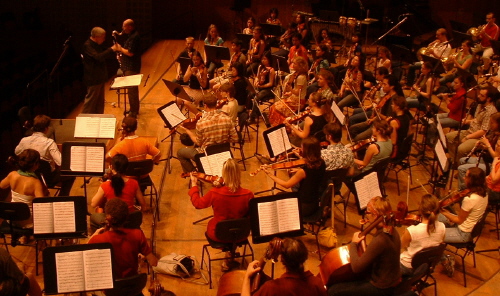
Pierre Boulez rehearsing Bruno Mantovani's bass clarinet concerto
The 124 invited members of the Academy from a multitude of nations had surmounted a rigorous admission procedure and auditioning to come and participate in a lifetime's enriching experience with all expenses paid. Despite appropriate publicity, to my surprise and the Academy's consternation, UK was conspicuously not represented other than by one solo singer and one commissioned composer; there were no applications from British post-graduate students, although the Academy is conducted in English! Master classes in string quartet playing (Beethoven, Berg and Lachenmann - this year's composer in residence) were followed by three weeks study with members of Ensemble Intercontemporain of key contemporary works, the whole culminating in two orchestral concerts which we timed our visit to catch.
Cliff Colnot was in charge of the chamber orchestra, which began with Sparkle by Chinese-American Chen Yi, holder of this year's Roche Award (last year's was Harrison Birtwistle!) - a sparkler indeed! Claire Booth repeated her London success with Read's In my sky at twilight introduced at, we thought, excessive length by the American composer, whose music had at last reached Switzerland. Augusta expounded, somewhat gushingly, about her all-inclusive love of music and 'the repertoire' - the allotted time might better have been shared with analytic elucidation of Chen Yi's piece and of Carter's Asko Concerto, in which pairs of soloists counterpointed in apparent unawareness of each other.
Pierre Boulez himself had worked with the larger orchestra and we attended the rehearsal and concert premiere of an ambitious orchestral work commissioned by the Academy from Dai 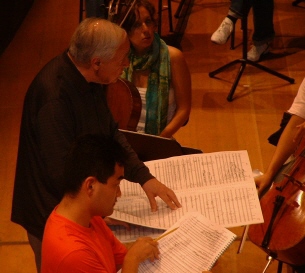 Fujikura, up-coming young Londoner already a featured composer in John Woolf's PLG Young Musicians series and receiver of a prestigious Gaudeamus Prize Honorable Mention for his
Fifth Station, performed by the Asko Ensemble conducted by Ilan Volkov in Amsterdam. Fujikara's Stream State for Lucerne had been worked up over two years, with Pierre Boulez in regular consultation and try-out opportunities with last year's Academy Orchestra. Fujikura, up-coming young Londoner already a featured composer in John Woolf's PLG Young Musicians series and receiver of a prestigious Gaudeamus Prize Honorable Mention for his
Fifth Station, performed by the Asko Ensemble conducted by Ilan Volkov in Amsterdam. Fujikara's Stream State for Lucerne had been worked up over two years, with Pierre Boulez in regular consultation and try-out opportunities with last year's Academy Orchestra.
Seen&Heard and Musical Pointers have followed Fujikura's career from early days and Stream State is a vibrant extrovert essay which makes effective play with an unusual disposition of the instruments; a nice touch was a line of violins across the back, quietly representing the Gagaku shô, an effect reminding one of Berio's delectable Voces . Hopefully in this case there was a social spin-off too, players from many countries sitting with different colleagues. It had you looking around to spot the sound and would go well in a televised Prom (BBC please note!). Dai told me that there is nothing in the whole world that can be compared with the Lucerne Academy
The public is welcomed to many of the Academy's teaching events and Boulez's final rehearsal was a relaxed and friendly occasion, but with no detail escaping his eagle ear and striving for perfection. At the concert, a pinnacle of Lucerne Academy 2005 and of our visit, the Academy strings achieved in Berg's Lyric Suite a sheen and delicate pianissimo not to be outshone by the Vienna Philharmonic who followed them; Christophe Bertrand's new piece for full orchestra made a positive impact and 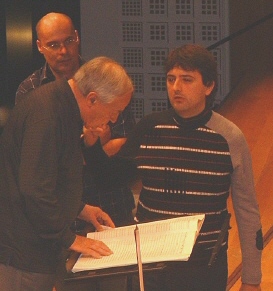 Bruno Mantovani's Bass Clarinet Concerto, based on fragments of Schubert, will have made new friends for his versatile and characterful instrument. All 124 musicians crowded the platform for an overwhelming performance of Varese's gigantic Amériques, the newest new music of the concert (1918/29) and the loudest too! Bruno Mantovani's Bass Clarinet Concerto, based on fragments of Schubert, will have made new friends for his versatile and characterful instrument. All 124 musicians crowded the platform for an overwhelming performance of Varese's gigantic Amériques, the newest new music of the concert (1918/29) and the loudest too!
Boulez, Billard & Mantovani at rehearsal, and above Dai Fujikara checking a point with Boulez
Re Bruno Mantovani see also
- -
Bruno Mantovani's oddly titled Turbulences for twelve instruments was an enjoyable exercise in saturated romantic sound, everyone getting his turn to shine, the whole decorated with swirling trills and arabesques; nothing at all radical here - -
and review of his bass-clarinet concerto "mit ausdruck" on CD
|
FESTIVAL STRINGS LUCERNE
ACHIM FIEDLER Conductor
SERGEY KUZNETSOV Piano
Mendelssohn
Sinfonia VI in E flat major for String Orchestra
Concerto for Piano and String Orchestra in A minor (1923/24)
Schubert Quartet in C minor, D 703, «Quartettsatz» (1820) (arr. for String Orchestra)
Helmut Schmidinger Nur ein Hauch! - und er ist Zeit» A Fantasy on Schubert's D 703 for String Orchestra (2002)
Janácek Suite for String Orchestra (1877
|
|
PIANO MORNING (Mendelssohn and Boulez) A clash on Sunday morning that would have bothered no one other than music critics had simultaneously Mendelssohn juvenalia at the KKL and wall-to-wall Boulez in Lucerne Theatre. Mendelssohn's A minor piano concerto is as garrulous and vapid as one might expect, but delighted the audience (stalls, first and second circles full) who seemed to think it was exactly how a piano concerto should go, without a large orchestra to take attention away from the endless runs, arpeggios and arabesques with which the boy was flexing his compositional wings in music for his sister Fanny to perform. Listening time would have been spent more rewardingly that day hearing a concert of Fanny's own choral music, given ex-festival in the Jesuit Church.
Preceding young Felix's student concerto was one of his even earlier little symphonies of 1821, played for all it was worth and more by the crack Lucerne Festival Strings, who ended with Janacek's undemanding 1877 Suite, composed before he had found his voice.
The concert was nearly saved with an interesting novelty by Helmut Schmidinger, a postlude to Schubert's famous Quartettsatz expanded for string orchestra; an expression of Schubert's feelings of distress and sadness, joined seamlessly to the original, making a bridge towards modernity for this morning audience.
|
| PIERRE-LAURENT AIMARD Piano and Introduction TAMARA STEFANOVIC Piano
Pierre Boulez
Douze Notations pour piano (1945) Première Sonate (1946) Deuxième Sonate (1948) Troisième Sonate (1955-57) Incises pour piano (1994) Structures pour deux pianos Premier livre (1951/52) Deuxième livre (1er et 2eme chapitres) (1956-61) A commentated Workshop
|
|
Across the way along the river bank was a marathon Boulez event, which Pierre-Laurent Aimard is touring in honour of the great man's 80th birthday and, here, as a tribute to his creation of the Lucerne Academy, which may prove one of his most valuable legacies.
Pierre Boulez's entire piano music was given, shared between Pierre-Laurent Aimard and his pupil and now collaborator, Tamara Stefanovic. They shared the sonatas and joined forces for the two-piano Structures and Aimard's introductions clearly captivated and held the attention of the large audience, stalls and circle full.
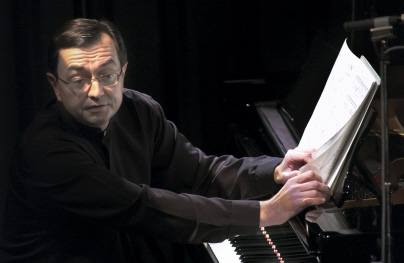 Unable to follow those in German, and regretting the absence of English translations of the extensive programme notes, I tried once more to comprehend, and maybe even enjoy, Boulez's espousal of uncompromising serialism! I listened through two of the four hours, mystified as ever by Boulez's rigorous syntax and unconvinced that the massive four-movement second sonata shared both form and stature with Beethoven's Hammerklavier . Best for me was Incises (1994) , the brief original solo version of what was to be magnified and elaborated into the dizzyingly complex Sur Incises, whose piled on counterpoint I've found too much of a good thing; the solo original is relieved by some old-fashioned virtuosity and attractive piano resonances. Unable to follow those in German, and regretting the absence of English translations of the extensive programme notes, I tried once more to comprehend, and maybe even enjoy, Boulez's espousal of uncompromising serialism! I listened through two of the four hours, mystified as ever by Boulez's rigorous syntax and unconvinced that the massive four-movement second sonata shared both form and stature with Beethoven's Hammerklavier . Best for me was Incises (1994) , the brief original solo version of what was to be magnified and elaborated into the dizzyingly complex Sur Incises, whose piled on counterpoint I've found too much of a good thing; the solo original is relieved by some old-fashioned virtuosity and attractive piano resonances.
|
WIENER PHILHARMONIKER
Christoph Eschenbach Conductor
Bruckner Symphony No. 8
|
|
VIENNA PHILHARMONIC ORCHESTRA Our week had the residency of this great orchestra, fresh from the London Proms with three conductor.
We were able to hear Bruckner under Christoph Eschenbach (Symphony No. 8, Ed. Nowak) and Mahler (Symphony No 1, plus Strauss and Wagner) under the UK Royal Philharmonic Orchestra's popular chief conductor, Daniele Gatti . For British concertgoers at Lucerne, it was disconcerting and salutary to be reminded that women have not yet stormed the male bastion of this orchestra significantly, though a few were to be spotted playing, amongst them several who are not yet designated 'members' of the venerable orchestra.
Bruckner's lengths are heavenly for some, but allow others minds to meditate and wander, none more so than No 8, the longest. Mine found itself wondering irreverently if Bruckner's repetitions of small units and slow major transistions were not the progenitor of Reichian minimalism; and even to thinking about needles getting stuck in shellac records...
For many generalists Bruckner is an acquired taste, maintained precariously. Last year at Lucerne we were moved and our attention riveted by the same monstrous symphony in the same hall given by Mehta and the Israel Philharmonic. I have become recently a devotee of Gunter Wand's DVDs with the
NDR Sinfonieorchester
which he'd nurtured.
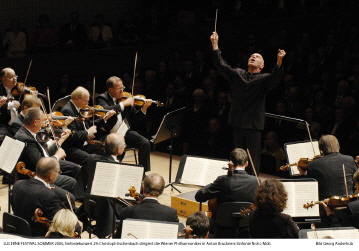 Eschenbach and the Viennese set me back into a doubter, totally unmoved by the final peroration [pictures] in which themes from the previous three movements are combined in a contrapuntal tour de force, which ought to be a consummation. As an example of what was wrong, I mention the the trumpets, bells held aloft over music stands, reminding me of the lethal lazer-like lead trumpet of the Boston Symphony Orchestra, once suffered in London. Eschenbach and the Viennese set me back into a doubter, totally unmoved by the final peroration [pictures] in which themes from the previous three movements are combined in a contrapuntal tour de force, which ought to be a consummation. As an example of what was wrong, I mention the the trumpets, bells held aloft over music stands, reminding me of the lethal lazer-like lead trumpet of the Boston Symphony Orchestra, once suffered in London.
Poor blend and balance suggested that Eschenbach had not rethought his sound palette in the KKL, and that maybe all would have sounded better in the home Musicverein or in a more forgiving Royal Albert Hall? Despite many beauties in quieter music, I was surprised that for sheer sound quality I far preferred my DVDs, on modest equipment at home, to the VPO in Lucerne.
The leading London critics reviewed the VPO'sLondon performance just before their Lucerne visit - one for, one against; a draw - the cricketing metaphor must be forgiven writing on the day that England regained The Ashes!
I think it better to leave my disappointment be, and to defer for an informed appreciation of Eschenbach's Bruckner 8 at the Proms to Marc Bridle, my friend and former assistant at Seen&Heard, and now its editor; a Bruckner/Mahler specialist who can even explain why it was a wise decision by Eschenbach to use that particular 1890 edition. |
Daniele Gatti Conductor
Richard Strauss «Tod und Verklärung» (Death and Transfiguration), Symphonic Poem, Op. 24
Richard Wagner Good Friday Music from Parsifal
Gustav Mahler Symphony No. 1 in D major |
|
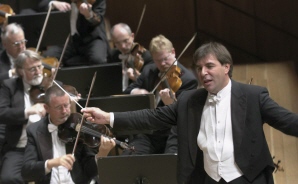 All music criticism is heavily subjective. Next night the VPO under Gatti sounded as if it were a totally different band. Lustrous Wagner and Strauss (Death & Transfiguration, my unfavourite of his tone poems) showed us what can be achieved by the coming together of a sensitive conductor, a great orchestra and a concert hall acoustic to match. Mahler's No.1 passed from a dreamy improvisatory feel in the folksy introduction, through the contrasts of heavily accented ländler via the Frere Jaques irony to the uninhibited finale,the grandiosity of its peroration wholly convincing and having us on the edge of our seats, the cumulative tension finally broken with roars of approval and a standing ovation to be compared with that at The Oval earlier the same evening! All music criticism is heavily subjective. Next night the VPO under Gatti sounded as if it were a totally different band. Lustrous Wagner and Strauss (Death & Transfiguration, my unfavourite of his tone poems) showed us what can be achieved by the coming together of a sensitive conductor, a great orchestra and a concert hall acoustic to match. Mahler's No.1 passed from a dreamy improvisatory feel in the folksy introduction, through the contrasts of heavily accented ländler via the Frere Jaques irony to the uninhibited finale,the grandiosity of its peroration wholly convincing and having us on the edge of our seats, the cumulative tension finally broken with roars of approval and a standing ovation to be compared with that at The Oval earlier the same evening!
|
BRIGITTE LANG Violin YVONNE LANG Piano
Ludwig van Beethoven
Sonata for Piano and Violin in A minor, Op. 23 Sonata for Piano and Violin in F major, Op. 24, «Spring» Sonata for Piano and Violin in A major, Op. 47, «Kreutzer»
|
|
RECITALS Lang Duo The Lucerne sisters Brigitte & Yvonne Lang, supported by their whole family's presence, amply justified their prestigious appearance at the Festival, packing the Schweitzerhof Hotel's ornate 400-seat chandeliered but unventilated hall. Beethoven's Op 23, the Spring and the Kreutzer , made for an enthralling afternoon, attracting older listeners, as is the way. We all marvelled at the maturity of the young musicians on stage, who had to contend with over-heat which needed towels, rather than handkerchiefs, to wipe away moisture between movements.
With everyone loyal to their own favourite interpretations on CD, the challenge of a Beethoven sonatas recital is a supreme one, even though good live music-making may for its duration eclipse recorded memories temporarily. This duo thinks as one, and their balance of tone and personality was all one could hope for, with the fruits of deep thought evident throughout. There is a grace and femininity in their playing together, which does not preclude forceful assertion especially in their new-considered interpretation of the Kreutzer, with many felicities to relish. Brigitte is sub-principal of the NDRSO, Hamburg, and Yvonne is a local piano teacher - lucky her pupils to whom she is able to impart a keen ear for voicing of chords, and dynamic variety which allows her, with the lid fully raised, to give uninhibited power to important moments without ever overwhelming her sister's solo melody. One remembered that the early duo sonatas were published as 'for piano and violin' and Brigitte, a soloist with the Brahms violin concerto to her CD credit, was a sensitive accompanist as need dictated. There was no chance to escpae without an encore; might it be a Beethoven slow movement to leave us calm and completative? The choice of Fauré's quicksilver scherzo served perfectly, to suggest that this duo has a wider repertoire beyond the 'canon', and with its humour reflecting that of Beethoven's which they had caught effortlessly in his sonata scherzi.
|
| |
|
|
ROMAN PATKOLO Double Bass
ALEXANDRA VERBITSKAYA Piano and Harp
Albinoni Adagio
Giovanni Bottesini
Tarantella & Carnaval di Venice
Fauré Impromptu
Paganini Moses Fantasy(arr. for DBand Piano)
Walther Kuehne Eugen Onegin, for Harp
Sarasate Zigeunerweisen, Op. 20
MONDRIAN ENSEMBLE
DANIELA MÜLLER Violin CHRISTIAN ZGRAGGEN Viola MARTIN JAGGI Cello WALTER ZOLLER Piano Sandor Veress Trio for Violin, Viola and Cello (1954) Joseph Haydn Piano Trio in A major, Hob. XV/18 Michel Roth «erschöpfung» (exhaustion) for String Trio (2002) Johannes Brahms Piano Trio in B major, Op. 8 (1853/54; rev. Version 1889)
|
|
Patkolo and Verbitzkaya Double bass with harp is not an obvious combination and this event was not up to the usual standard of Lucerne Festival debut recitals Albinoni was heard in the old fashioned way with heavy vibrato, and in a succession of showpieces which relied upon superlative technical command both musicians had suspect tuning and uncertain control. The only item of Roman Patkolo's recital which I was able to really enjoy was Carnaval de Venice , a popular tune elaborated by Bottestini (a 19C virtuoso bassist), further arranged by his partner and accompanist Alexandra Verbitzkaya to make an effective ending to an easy-going concert which the undemanding Lucerne lunchtime audience received rapturously.
Totally different in aim and achievement was the Mondrian Ensemble, a widely acclaimed piano quartet whose members have played and trained in UK (Daniela Müller, Lucerne born, was recently in London with a scholarship to the Guildhall School). Their unusually structured lunchtime programme consisted of four trios, two for strings, two for piano trio. They presented impressive classical credentials in an HIP account of Haydn (his trios still needing advocacy, having been eclipsed by Mozart's for centuries), and a deeply thought and perfectly balanced Brahms Op.8 (revised version) which sent us out to lunch by the river Reuss richly satisfied.
The audience appreciated those fully, but were undaunted at all by the rather tough 1954 string trio of Veress (Hungarian born, from 1950 Switzerland his second home, and latterly championed by his pupil Heinz Holliger) - a strong two-movement work with obvious nods to Bartok in the fast second movement. For radical 'now' music on a flourishing Swiss scene, we had Erschöpfung from their 'house composer' Michel Roth's Mondrian Cycle (eponymous for the ensemble) - its abrasive energy took its toll of Martin Jaggi's cello bow, with a broken string right at the end!
The Mondrian Ensemble's CD (Grammont Portrait MGB CTS-M 88) was on sale; an unusual debut disc, very strongly recommended. Two modern classics for string trio - Scelsi's forward-looking trio of 1958 which explores in each movement the potential locked in a single note) and Ikhoor by Xenakis (1978) - are neither of them as well known as each deserves. The rest are Swiss originals; Michel Roth (b.1976) with an earlier piano trio in his Mondrian Cycle which takes Piet Mondrian's Composition with Red, Yellow & Blue as a cue for 'transformational processes' involving 'subtle intonational dissonances', and an eclectic string trio by another, Dieter Ammann (b.1962), who plays entertainingly with clichés, full of surprises. And Michel Jaggi, the ensemble's cellist, who is worthily represented as composer by Scbebka for the core ensemble plus double bass, a powerful work deriving from numerous journeys in Africa which 'expanded his knowledge far beyond the scientific and cultural' (bassists should carry the score of Scbebka around with them to rehearsals for their Trout gigs!). We must hope that the Mondrian Ensemble will soon be invited to Wigmore Hall in London (or to The Warehouse or Blackheath Halls) as ideal ambassadors for new Swiss chamber music, a rich quarry yet to be explored in UK.
|
| |
|
MUSIC THEATRE AND OPERA |
ENSEMBLE ÆQUATUOR
with guests SYLVIA NOPPER Soprano HELMUT VOGEL Actor MATTHIAS ARTER Oboe TOBIAS MOSTER Cello VLADIMIR BLAGOJEVIC Accordion INGRID KARLEN Piano PETER SCHWEIGER Director DANIELLE STRAHM Assistant Director PASCALE WIEDERMANN Stage and Costume Design MATTHIAS ARTER Artistic Director (æquatuor) STEFANIE HÄBERLE Production Manager «Schattenrisse» - Two Chamber Operas
Nadir Vassena «Schlaflos» Libretto by Mascha Kurtz First performance
Alfred Zimmerlin «Euridice singt» Libretto by Raphael Urweider First performance
CONTINUUM ENSEMBLE
American trailblazers:Charles Ives, John Cage,
Conlon Nancarrow &c |
|
CONTINUUM at the BOA Centre
Billed as a recital, Continuum's concert belongs equally to my music theatre section, certainly more deservingly so than Ensemble Æquatuor's attempt to break out from chamber music confines onto the stage. Nadir Vassena's drear hour-long piece Sleepless , about a dressing-gowned insomniac who might have murdered his brother, was enjoyed none the better by my German-speaking wife and it drove us out rather than risk its companion piece about a singing Euridice and her more reticent Orpheus... The music for Sleepless sounded desultory and failed to illuminate or relate to the libretto. Quite the opposite at the theatre next night was The Trojan Boat , a visiting quasi-operetta (ex-festival), a hilariously funny concotion about competition for a captivating Princess in two islands, one belligerent, the other 'cultured', its musical collage always pertinent to the story.
New York's Continuum Ensemble was first encountered by the writer in a castle during Luxembourg's ISCM Music Days, with the 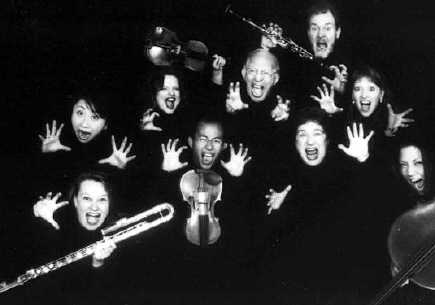 anarchic Francis Schwarz's Scream (pictured) stirring up an unsuspecting audience. anarchic Francis Schwarz's Scream (pictured) stirring up an unsuspecting audience.
Founded 1966 by pianists Cheryl Seltzer and Joel Sachs, the group brought American Pioneers to the BOA Culture Centre, a pleasant convivial meeting place in Lucerne for all the arts, just a few bus-stops from the city centre. It was a perfect venue for presenting their new programme of music by composers they have long been associated with (q.v. my reviews of Continuum's recordings in the Naxos American Classics series).
First the two founders began with a group of Nancarrow's finger-twisting inventions, most of this iconoclast's music punched out in Mexican exile on player-piano rolls, at a time when the composer's thoughts had gone far beyond the dexterity of concert pianists of the time. Now some of them are being tackled with zest by the new generation of virtuosi, in arrangements by Yvar Mikhashoff. Watching Seltzer and Sachs despatch the 1940 Sonatina for four hands as easefully as if it were a schoolrom duet (with the obligatory crossed-hands) was a particular joy.
The whole programme was a carefully choreographed visuo-musical experience, culminating in exhilarating music theatre with the outrageous Aria from Cage's Concert for Piano and Orchestra , here reduced to the five Continuum musicians who made themselves sound far more. Carol (no longer in the first flush of youth) was required to crawl under the piano besides playing on keyboard and under the lid on the strings, whilst Joel directed the motley crew, semaphoring like a policeman on points duty.
Violinist Renée Jolles (concertmaster of the democratic conductorless Orpheus Chamber Orchestra) interposed a poised moment of calm with Feldman's mercifully brief Vertical Thoughts , and she contributed to Henry Cowell's totally successful demonstration of five ways in which violin can live comfortably in trio with piano and percussion. The Set of Five (1952) had percussionist Tom Color playing a range of instruments with utmost delicacy; he had china bowls with (chop)sticks and a muted set of cymbals laid down on a sheet, only for the final note one of them held up and allowed to quietly ring out. Joel Sachs at the piano combined with discretion to make the whole alluring work one that deserves a firm place in concerts for mixed chamber ensembles.
Tom Color let himself rip for the loudest moments of the morning, a notional Improvisation (though I doubt it?) for four timpani by the younger innovator Elliott Carter, nearing 100 and still pioneering. Chinese-American mezzo Bo Chang has not yet recorded with Continuum but must do so without delay. Her aplomb in giving seeming meaning to Gertrude Stein's surrealist nonsense as set by Virgil Thomson, and her power and inspired conviction in Two Ricercari by Ruth Crawford Seeger, whose light shines ever more brightly, made a memorable centre piece for the first half of this generous programme. They were settings of political protest poems by Tsiang (published in The Daily Worker, 1928) about futile war deaths (then and now) and exploitation of immigrant workers in Chinaman, Laundryman , both with resonances which will endure for many of us in the receptive audience who got up early enough on a Saturday morning to participate.
All that was missing was a camera to video that model concert, exactly as it was unpretentiously presented, and in Lucerne's ideal setting. Hopefully a sponsor will be forthcoming for a DVD next year to celebrate Continuum's fortieth birthday?
|
Stravinsky The Rake's Progress
Luzerner Theaters
in association with Lucerne Festival
Alexander Schulin (Inszenierung)
Christian Schmidt (Bühne und Kostüme),
Dr. Christian Kipper (Dramaturgie)
Tanja Ariane Baumgartner, Simone Stock,
Caroline Vitale, Auke Kempkes, Jason Kim, James Moellenhoff, Martin Nyvall,
Marc-Olivier Oetterli
John Axelrod/Luzerner Sinfonieorchester,
Chor und Extrachor des Luzerner Theaters
(Performances scheduled until 17.11.05)
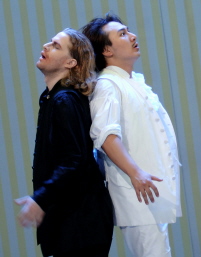
Tom & his Shadow
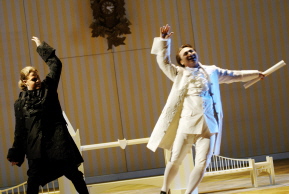
In London - at Tower Bridge
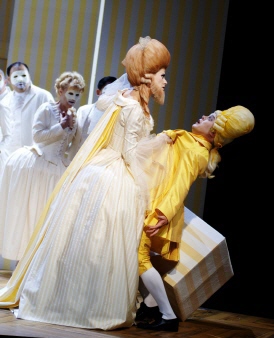
Baba & Sellem
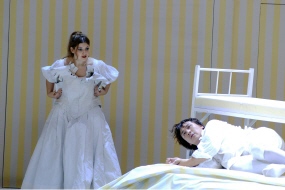
Bedlam
|
|
The Rake's Progress
Having seen many productions of Stravinsky/Auden/Kallman's The Rake's Progress since the 1940s, Lucerne Theatre's intimate and simplified, but never simplistic, staging rates as one of my very best experiences of what was, in earlier days, a controversial opera, one which has never become easy for performers or listeners.
We meet Anne and Tom as playful late adolescent lovers making cut-out birds and funny hats from plain white paper (qv. Mnozil's boat, below). White is the prevailing colour for this ever blacker tale, Christian Schmidt's economically evocative sets (e.g. London represented by a little model of Tower Bridge, see picture) were brightened by Gerard Cleven's effective lighting. Yellow was used as an incongruous element to point up the contrast between illusion and reality.
The youthful casting was entirely right for the concept of this production, especially that of Tom and Anne, Jason Kim and Simone Stock , both fully equipped young opera singers who had nothing to fear by comparison with their more mature predecessors in the roles. The costuming was especially meaningful. Anne, wearing contemporary jeans visible throughout under hers, represented solid normal reality in our own times, with which she never lost contact, whilst her poor Tom, attired in progressively more elaborate white costumes as he gradually became embroiled completely in a world of fantasy, took us into the 18th century and descent into, then untreatable, madness. Subtle correspondences between white (Tom) and black (Shadow) needed sharp eyes if they were not to be missed. Finally hospitalised, with his fellow patients believed to be his courtiers, Anne went along with her assigned role as Venus to his as Adonis (thus he's 'easily managed', explained the asylum warden) and after visiting him in Bedlam she withdrew back to the real world of her carpet-slippered father.
This is a case where less is more; likely budget constraints were turned to advantage in Alexander Schulin's production, which concentrated our minds upon the tragi-comedy of the self-deluding Tom, who destroys himself with the collaboration of his alter-ego. His Shadow is depicted at first as a persuasive con-man, a charmer who doesn't look in the least devilish until the day of reckoning, and by whom Tom is easily drawn into scatterbrained disasters, sexual and financial, one after another. Marc-Oliver Oetterli 's suave portrait of Tom's Shadow gave way to menace in the the three-card game; losing the gamble sent Shadow, fearful but defiant, into the grave prepared for Tom, who was in turn saved from self-knowledge by (? syphilitic) madness (allusions to Turandot and Don Giovanni in this referential opera).
None of the usual grotesques appear in this version; Mother Goose is an attractive establishment madam ; the bearded Baba strikingly beautiful, with as without her fetching facial adornment. Tanya Ariane Baumgartner 's splendid name matched her luscious contralto as Baba and her depiction of a 'lady of the stage' whose talents would ensure she was never at a loss to make a living (she ought not to remove her beard for curtain calls!). Hogarth and his time is fleetingly recalled with the elaborate tall wigs of Baba and the auctioneer who disposes of her tawdry collection of possessions, here left to our imaginations in their cardboard boxes after a shopping spree. Martin Nyall 's auctioneer was a marvel of authoritative presence and superlative diction in a rewarding cameo part, always a hit, right back to memories of the veteran, now centenarian, Hugues Cuenod.
John John Axelrod had the expert musicians of Luzerner Sinfonieorchestra to underpin the stage goings on and achieved a perfect balance between hard edged objectivity in the earlier acts and expressive poignancy for Tom's descent into Greek mythology and Anne's withdrawal into the real world at the end.
The masked chorus sang strongly with Stravinskian precision, and by simple touches of presentation suggested prostitutes, consumerist bargain hunters and psychotic patients.
With Anne's father alone a native English speaker, the cast's mastery of the language and of Auden's meanings was impressive for British visitors, though others may have had problems following the black on dark green surtitles which were not projected brightly enough. Stravinsky was reluctant to undertake this opera commission, but The Rake's Progress has achieved classic status, one of those operas, like Mozart's, which are assured of revitalisation through the generations, and will surely continue to be revived into future centuries.
We have still vivid memories of several opera productions by Lucerne Theatre during previous festivals (notably Stallerhof & The Emperor of Atlantis) and this Rake will be remembered as lastingly as any of them. Tickets are put on sale separately, which might help to explain why attendance was poor for so prestigious a music-theatrical event, but the reception by a small audience was ecstatic, with long continuing curtain calls, so hopefully news of its quality will spread by 'the grape-vine' to ensure full houses before the run ends in December.
A video record of this new production is obligatory, and a DVD should be seriously considered - uncomplicated filming of small scale productions can often make the best home viewing, and this Lucerne version could take pride of place against misguided and over-elaborate Rakes such as Jörg Immendorff's 1996 Salzburg Festival production (Arthaus DVD).
See extensive archive of Monika Rittershaus's photos of this production at http://www.luzernertheater.ch/news/presse/bildarchiv |
MNOZIL BRASS ENSEMBLE
Luzerner Theater
Operetta The Trojan Boat
thomas gansch - roman rindberger - robert rother - gerhard füßl - leonhard paul - ed partyka - wilfried brandstötter |
|
The Trojan Boat 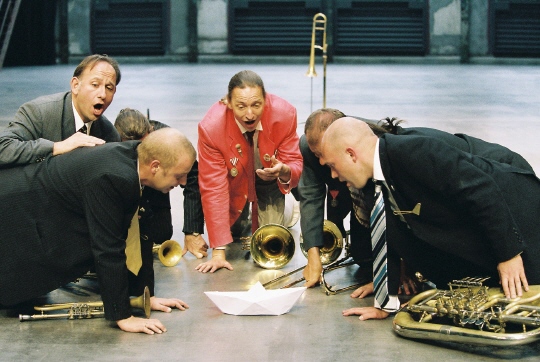
Photo: Ursula Kaufmann All the way from Vienna to the shores of Lake Lucerne, Mnozil's Das Trojanisches Boot (above) landed on the stage of the adventurous Lucerne Theatre.
Every bit as intriguing and unexpected as its famous counterpart, the Trojan Horse of antiquity, this new interloper is subtly subversive. The Trojan Boat is not deviously bent on destructive aggression but rather on explosively funny undermining of pomposity and belief in warmongering. Indeed the boat itself was a tiny folded paper affair sitting forlornly and totally inoffensively on stage.
The cast of seven versatile individualist, brass players who met and trained at the famous Vienna Music Conservatoire, now operate, when other pretigious duties allow, as the Mnozil Brass Ensemble. Each member a technically brilliant instrumentalist; they are all also, unusually for classically trained musicians, sing well and are outstanding mime artists who, with minimal facial gestures and body movements they totally captivate their audiences.
Das Trojanisches Boot is billed as The First Operetta of the 21st Century . It owes something to the culturally important genre of cabaret, where social and moral issues can be tossed at the audience. The seemingly facile story of the effect of a fascinating new arrival, a boat harbouring a desirable Pincess and wedging itself between two culturally and socially different island communities sometime before Christopher Columbus, points up divergent aspirations and ensuing conflicts, taking stabs at our own social mores.
Mnozil Brass Ensemble and their director Bernd Jeschek , have cleverly embedded bullets into their salvos of musical and verbal jokes. Musical idioms expressive of the spoken and sung texts are seamlessly intertwined and the singing and choral spoken narration was delivered with as much artistry and panache as their instrumental playing.
This is sophisticated cross-over music making, not readily classifiable but totally enthralling. The audience was blown apart by the sheer exuberance of it all and demanded an indecent number of (it transpired) prepared encores before we emerged holding our sides aching with laughter, even those non-German speakers amongst the international festival audience who had to rely on visual clues and the technical bravura of these musicians. The last act depends less on text; it is like one of those classical ballet last acts in which there is a succession of party pieces.
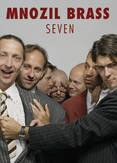 On the way out PGW commented that a DVD of this show with the usual multi-lingual subtitles was desirable to spread knowledge further afield of Mnozil Brass and their boat; in the foyer we found that a Mnozil Brass Seven DVD (not the Trojan Boat) was indeed on sale; it is a concert without any underlying theme, with some of the very funny set pieces from the last act of Trojanisches Boot; you get to know these seven endearing characters and will enjoy it all as much as did the live audience at the DVD filming. On the way out PGW commented that a DVD of this show with the usual multi-lingual subtitles was desirable to spread knowledge further afield of Mnozil Brass and their boat; in the foyer we found that a Mnozil Brass Seven DVD (not the Trojan Boat) was indeed on sale; it is a concert without any underlying theme, with some of the very funny set pieces from the last act of Trojanisches Boot; you get to know these seven endearing characters and will enjoy it all as much as did the live audience at the DVD filming.
Do buy it for
€ 22 direct from Mnozil and look out for a future DVD of the Boat; with a choral speaking narrative it definitely represents a significant advance in the multi-skills of these brilliant performers.
See http://www.mnozilbrass.at/95.html
and Mnozil Ensemble's website for portrait and details of remaining performances of das trojanische boot
P.S. + extra performance December 18 2005 in response to its great success PGW
Alexa and Peter Grahame Woolf |
|
|
|
|
|
|
|
|
|
|
|
|
|
|
|
|
|
|
|
|
|
|
|
|
|
|
|
|



